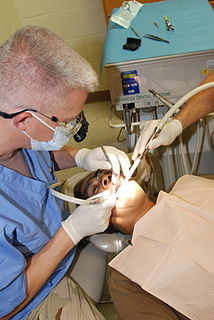
Dentistry, also known as dental medicine and oral medicine, is a branch of medicine that consists of the study, diagnosis, prevention, and treatment of diseases, disorders, and conditions of the oral cavity, commonly in the dentition as well as the oral mucosa, and of adjacent and related structures and tissues, particularly in associated maxillofacial area. The field of dentistry or dental medicine includes teeth as well as other aspects of the craniofacial complex including the temporomandibular joint and other supporting, muscular, lymphatic, nervous, vascular, and anatomical structures. The practitioner is called a dentist.
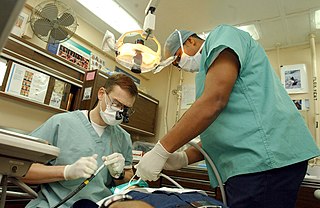
A dentist, also known as a dental surgeon, is a medical professional who specializes in dentistry, the diagnosis, prevention, and treatment of diseases and conditions of the oral cavity. The dentist's supporting team aids in providing oral health services. The dental team includes dental assistants, dental hygienists, dental technicians, and sometimes dental therapists.
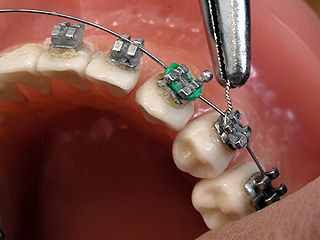
Orthodontics is a dentistry specialty that addresses the diagnosis, prevention, and correction of mal-positioned teeth and jaws, and misaligned bite patterns. It may also address the modification of facial growth, known as dentofacial orthopedics.

Tooth decay, also known as dental caries or cavities, is the breakdown of teeth due to acids made by bacteria. The cavities may be a number of different colors from yellow to black. Symptoms may include pain and difficulty with eating. Complications may include inflammation of the tissue around the tooth, tooth loss and infection or abscess formation.

Endodontics is the dental specialty concerned with the study and treatment of the dental pulp.
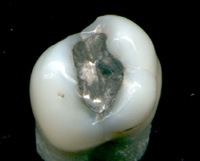
This discussion of the dental amalgam controversy outlines the debate over whether dental amalgam should be used. Supporters claim that it is safe, effective and long-lasting while critics argue that claims have been made since the 1840s that amalgam is unsafe because it may cause mercury poisoning and other toxicity.

The British Dental Association (BDA) is a registered trade union for dentists in the United Kingdom.
The water fluoridation controversy arises from political, moral, ethical, economic, and health considerations regarding the fluoridation of public water supplies.

The Canadian Dental Association is a non-profit professional association representing Canada's 18,000 dentists. Headquartered in Canada's capital city Ottawa, the CDA serves its members and the public by managing key oral health issues on their behalf and by coordinating dental health awareness programs across the nation.
The General Dental Council (GDC) is an organisation which regulates dental professionals in the United Kingdom. It keeps an up-to-date register of all qualified dentists and other dental care professionals such as: dental hygienists, dental therapists, dental nurses, dental technicians and clinical dental technicians. It was established in 1956 to set and maintain standards in UK dentistry, with the aims of protecting the general public from unqualified dental professionals.
The Journal of the American Dental Association is a monthly peer-reviewed medical journal on dentistry published by the American Dental Association. It is freely available to the public after a one-year embargo. The journal was first published in 1913 as Official Bulletin of the National Dental Association. It was renamed The Journal of the National Dental Association in 1915, and Journal of the American Dental Association in 1922. It merged with Dental Cosmos in 1936. Marjorie Jeffcoat became the first female editor of the journal in 2001.
Oil pulling is an alternative medical practice in which an edible oil is swished around the mouth for a period of time and then spat out, similar to mouthwash.

Dental attrition is a type of tooth wear caused by tooth-to-tooth contact, resulting in loss of tooth tissue, usually starting at the incisal or occlusal surfaces. Tooth wear is a physiological process and is commonly seen as a normal part of aging. Advanced and excessive wear and tooth surface loss can be defined as pathological in nature, requiring intervention by a dental practitioner. The pathological wear of the tooth surface can be caused by bruxism, which is clenching and grinding of the teeth. If the attrition is severe, the enamel can be completely worn away leaving underlying dentin exposed, resulting in an increased risk of dental caries and dentin hypersensitivity. It is best to identify pathological attrition at an early stage to prevent unnecessary loss of tooth structure as enamel does not regenerate.
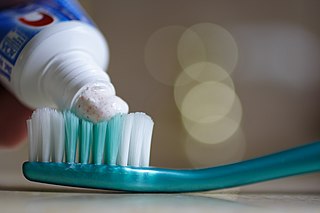
Oral hygiene is the practice of keeping one's mouth clean and free of disease and other problems by regular brushing of the teeth and cleaning between the teeth. It is important that oral hygiene be carried out on a regular basis to enable prevention of dental disease and bad breath. The most common types of dental disease are tooth decay and gum diseases, including gingivitis, and periodontitis.

The Columbia University College of Dental Medicine, often abbreviated CDM, is one of the twenty graduate and professional schools of Columbia University. It is located at 630 West 168th Street in Manhattan, New York City. According to American Dental Education Association, CDM is one of the most selective dental schools in the United States based on average DAT score, GPA, and acceptance rate. In 2014, 2,029 people applied for 80 positions in its entering class. The median undergraduate GPA and average DAT score for successful applicants in 2014 were 3.7 and 23, respectively.
The American Dental Society of Anesthesiology (ADSA) is an American professional association established in 1953 and based in Chicago.
The Journal of Dental Research is a peer-reviewed medical journal that covers all aspects of dentistry. The editor-in-chief is Nicholas Jakubovics. It was established in 1919 and is published by Sage Publications on behalf of the International and American Association for Dental Research.
BDJ Team is a peer-reviewed online magazine published by Nature Research on behalf of the British Dental Association - of which it is a fellow publication of the latter's official journal, the British Dental Journal. The editor-in-chief is Stephen Hancocks. The journal replaced Vital, which was published between 2003 and 2013.











